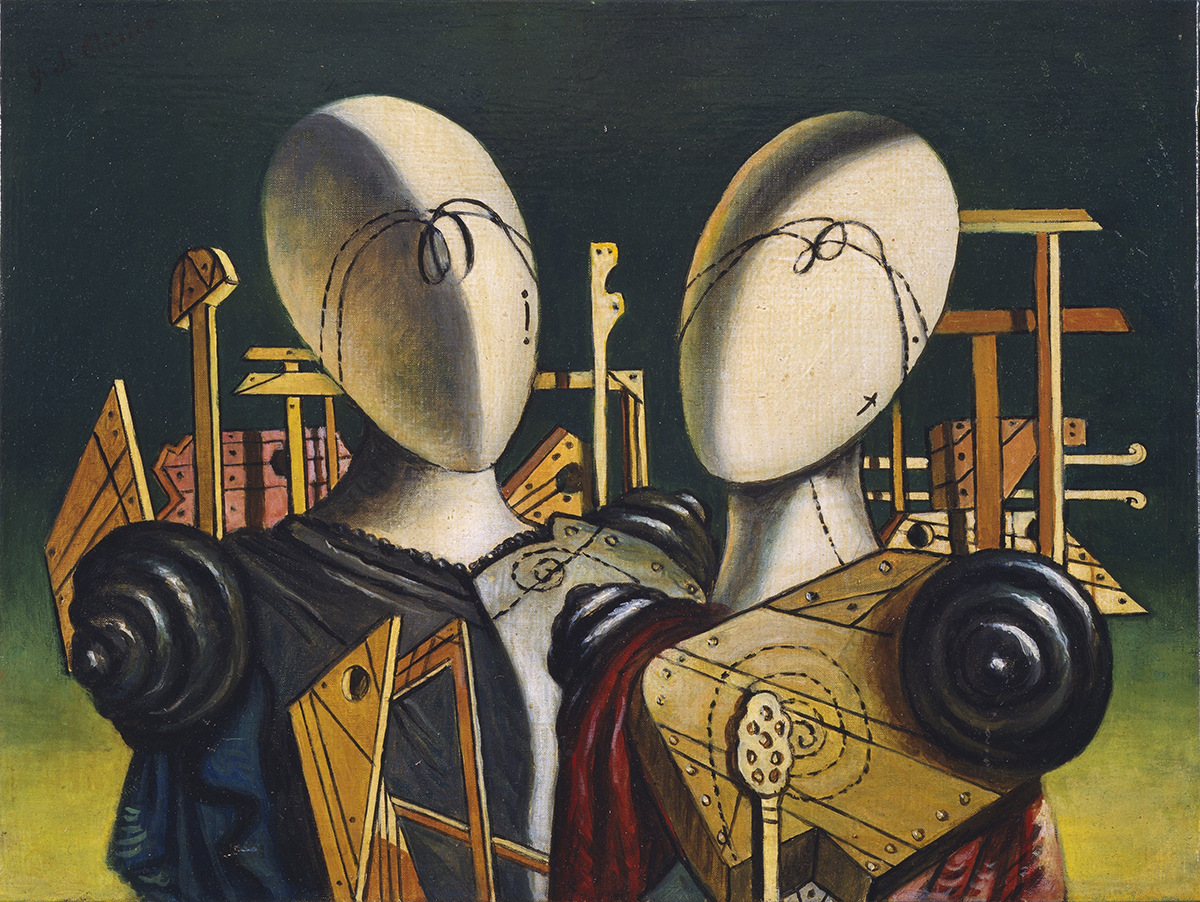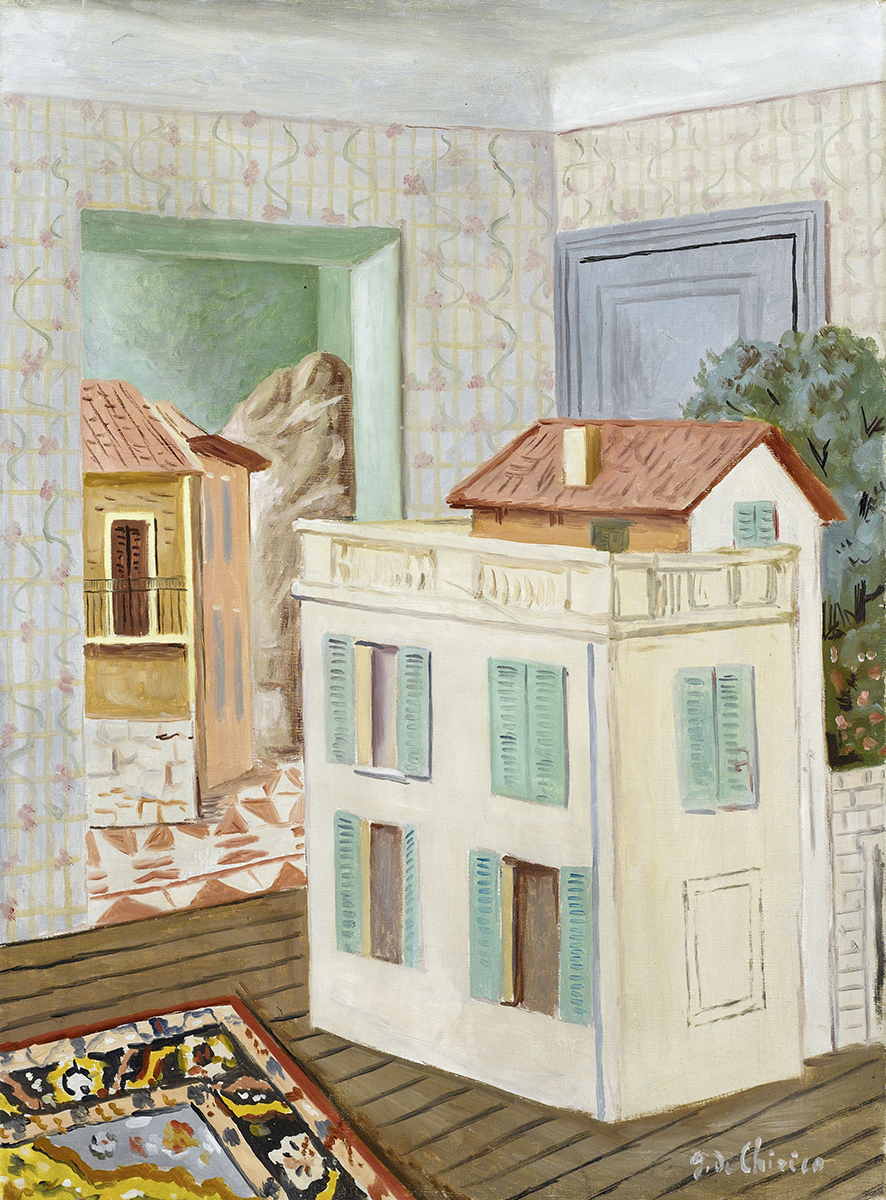GIORGIO DE CHIRICO: METAPHYSICAL JOURNEY
HAPPENINGText: Alma Reyes
It would not be complete to think of de Chirico without his emblematic mannequins. His steady fixation for the faceless and egg-shaped heads of such figures may have sprouted from the devastation brought by World War I, when confusion and hollowness swept the world. The mannequins are devoid of any rationality nor expression, sometimes portrayed as muses, poets, philosophers, or characters from historical literature. They sit or stand before an arcaded temple, monument or central plaza, or in some cases, are surrounded by statues and battle scenes. Mannequins played an essential role in the artist’s characterization of metaphysical art.

Giorgio de Chirico, Hector and Andromache, 1970, Fondazione Giorgio e Isa de Chirico, Roma © Fondazione Giorgio e Isa de Chirico, Roma © Giorgio de Chirico, by SIAE 2024
His notable series of Hector and Andromache, lifted from Homer’s Trojan War, are the artist’s most popular mannequin subjects. The humanized expression of the couple bidding farewell to each others is enlivened through de Chirico’s revived use of tempera and oil technique. He also employed chiaroscuro to achieve denser and lighter colors.

Giorgio de Chirico, The House with the Green Shutters, 1925–26, Private Collection © Giorgio de Chirico, by SIAE 2024
The exhibition displays themes of gladiators and objects in reversed location, a pattern de Chirico developed from the 1920s. Seas and mountains are spotted indoors, while furniture sit outdoors — a reference to furniture brought outside during an earthquake in Athens. The House with the Green Shutters (1925-26) shows an exterior landscape inside the enclosed room with a ceiling low enough to reach the sky, again, associated with human’s close relationship to Greek mythological gods.
Although de Chirico’s works after the 1920s manifested a revisit to traditional art, as demonstrated by inspirations from Renoir, Delacroix and Courbet, the period of anti-modernism and Neo-Baroque came to a standstill in the 1960s. A new style, Neo-metaphysical painting arose, which transformed elements from the artist’s past works into mixed settings of lively images and organic forms, like the sun and moon and ambiguous configurations. The works incite more unflinching freedom and enter the sphere of postmodernism.

Giorgio de Chirico, Return of Odysseus,1968, Fondazione Giorgio e Isa de Chirico, Roma © Fondazione Giorgio e Isa de Chirico, Roma © Giorgio de Chirico, by SIAE 2024
The spellbinding Return of Odysseus (1968) serves as an autobiographical testimony of de Chirico’s life — the armchair and wardrobe resembling pieces from his Paris apartment, and Odysseus rowing a boat on the sea made into a carpet, reflective of the artist’s days of sailing in Greece. A view of a Greek temple is seen on the picture on the right wall. The door on the right is ajar, opening to darkness — a metaphor of the artist’s aging state of nostalgic boyhood.
The exhibit also includes a hall of bronze sculptures, completed in the artist’s latter years, as well as a stage of colorful theatrical costumes and their sketches created for ballets and other performing arts from the mid-1920s to 1960s.
Giorgio De Chirico: Metaphysical Journey
Date: April 27th – August 29th, 2024
Opening Hours: 9:30 – 17:30 (Fridays till 20:00)
Closed on Mondays, July 9th – 16th
(Open the Mondays of July 8th, August 12th)
Place: Tokyo Metropolitan Art Museum
Address: 8-36 Ueno-Park, Taito-ku, Tokyo
Tel: +81 (0)50 5541 8600 (Hello dial)
https://dechirico.exhibit.jp
Text: Alma Reyes
Photos: Courtesy of Fondazione Giorgio e Isa de Chirico, Roma © Fondazione Giorgio e Isa de Chirico, Roma © Giorgio de Chirico, by SIAE 2024





